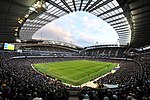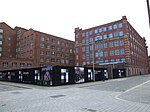Bradford Colliery
Bradford Colliery was a coal mine in Bradford, Manchester, England. Although part of the Manchester Coalfield, the seams of the Bradford Coalfield correspond more closely to those of the Oldham Coalfield. The Bradford Coalfield is crossed by a number of fault lines, principally the Bradford Fault, which was reactivated by mining activity in the mid-1960s. Coal had been mined at Bradford since at least the early 17th century, when the area around the pits was largely rural; it became increasingly built-up and industrialised as nearby Manchester expanded during the 19th century. Coal was transported from the colliery by canal and railway, but most was consumed locally by the adjacent Bradford Ironworks. In the mid-20th century a 469-yard (420 m) tunnel was dug to supply coal directly to the Stuart Street Power Station. Damage to buildings in the area around the colliery caused by subsidence led to it becoming uneconomic despite its sitting on large reserves of high-quality coal, and it was closed in 1968. The site was cleared and is now occupied by the City of Manchester Stadium.
Excerpt from the Wikipedia article Bradford Colliery (License: CC BY-SA 3.0, Authors).Bradford Colliery
Manchester Bradford
Geographical coordinates (GPS) Address Nearby Places Show on map
Geographical coordinates (GPS)
| Latitude | Longitude |
|---|---|
| N 53.483 ° | E -2.202 ° |
Address
Manchester, Bradford
England, United Kingdom
Open on Google Maps









